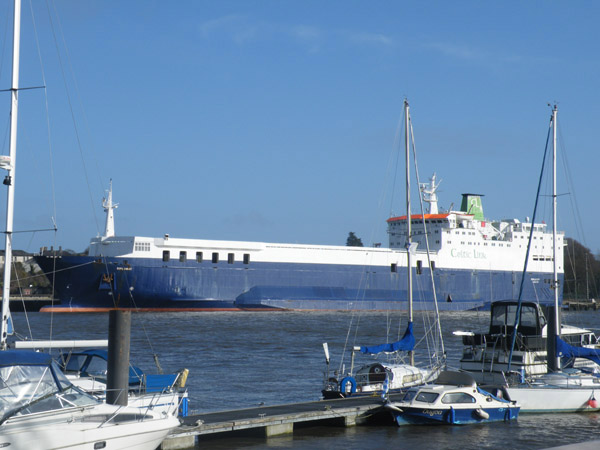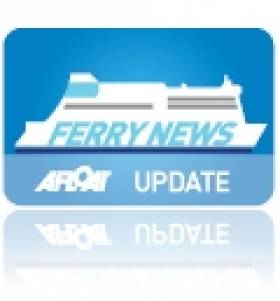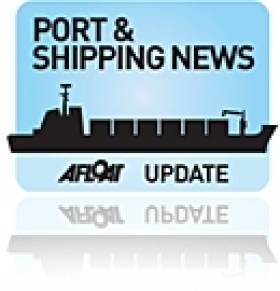Displaying items by tag: Diplomat
New Vessel on the Horizon for Celtic Link Ferries
With an increased capacity of nearly 1,000 passengers accommodated in 428 cabin berths, the vessel will offer a wider choice of bars, restaurents and childrens' play area compared to the current route ro-pax Norman Voyager, which like her successor was built by Italian shipbuilders Visentini. The 25-knot replacement ship will have 2,285 lane metre space for 800 cars or 150 freight vehicles.
Celtic Horizon becomes the first vessel to incorporate the companies name since foundation in 2005 when the freight-ferry Diplomat started operations. In recent years the company has secured the contract to import new trade vehicles from French manufacturers.
Before the newcomer makes her Autumnal debut, the 2006 built vessel is currently operating as Cartour Beta while on charter to Caronte and Tourist's (C&T) Salerno-Messina service in Sicily. To read more click here.
As for the Norman Voyager, she first entered as a newbuild in 2008 for LD Lines weekend operated Rosslare-Le Havre route, subsequently transferred to Cherbourg. LD Lines first foray into the Irish market was short-lived as the ro-pax was sub-chartered to Celtic Link Ferries the following year, though the French company are to transfer the vessel to their Marseilles-Tunis route in November.
- Diplomat
- Celtic Link Ferries
- Ports and Shipping
- RosslareCherbourg
- Norman Voyager
- Visentini
- RoPax
- FreightFerry
- Ferry news
- LD Lines
- Cartour Beta
- Caronte and Tourist
- Visentini ropax
- RosslareLe Havre
- SalernoMessina
- MarseillesTunis
- Irish ferry market
- IrishFrench ferry services
- Irish ferry sector
- Irish Ferries
- RoPax Norman Voyager
- Rosslare Port
- Rosslare Europort
- French trade vehicles
- Citreon
- Peugoet
- Renault
Celtic Link Ferries First Ferry Goes to the Breakers
Launched as the Stena Tranporter, the career of the 16,000 tonnes has spanned over three decades in which the 151m vessel changed through several owners and subsequent vessel renamings.
It was when she served under the name Baltic Ferry, that her most notable career took place in 1982 during her wartime deployment as part of the
Falklands Islands Task Force. The 151m vessel was requisitioned by the British Ministry of Defence which saw the ship engaged in military operations when RAF Harrier Jump-Jet aircraft transferred store supplies from the deck of the ship as part of the war-effort in the South Atlantic Ocean.
In 2001 the vessel undertook ferry operations to Ireland as the European Diplomat on the Dublin-Liverpool route for the P&O (Irish Sea) route network. The following year she was transferred on the direct route to France until P&O pulled the plug on the continental service in December 2004, leaving Irish Ferries as the sole operator.
It was not until February 2005 that the route resumed service but this time under new owners Celtic Link Ferries. The O'Flaherty brothers, owners of a large fishing fleet in Kilmore Quay purchased the vessel and renamed her Diplomat. See PHOTO.
For the next four years she built up a steady customer loyalty between freight-hauliers drivers and car-only accompanying passengers who were accommodated in the ship which had a limited passenger certificate for 114 passengers. In addition she had a license to transport livestock.
Currently Celtic Link Ferries operate the ferry Norman Voyager but the 800-passenger / 200-car ro-pax vessel will only remain on the route until an October debut of a larger sistership the Cartour Beta.
The vessel is running this season between Italy and Sicily and with an added deck the 27,552 tonnes vessel has an increased capacity for passengers, cars and enhanced range of facilities. Recently the company had run a competition to name the new vessel which is to begin a five-year charter on the service between Wexford and Normandy.
- Wexford
- irish sea
- Diplomat
- Celtic Link Ferries
- Kilmore Quay
- Stena Rederi
- Marine Express
- RosslareCherbourg
- Norman Voyager
- Ports and Shipping News
- Normandy
- RoPax
- DublinLiverpool
- P&O (Irish Sea)
- Ferry news
- Cartour Beta
- Irish Sea Ferries
- Stena Transporter
- Baltic Ferry
- European Diplomat
- O'Flaherty Brothers
- Falklands Islands Task Force
- Hyundai Heavy Industries
- Freighthauliers
- Livestock
- RAF
- Harrier JumpJets
Celtic's French Ferry Figures
Operating the route is the 2008 built ro-pax Norman Voyager, at 26,500grt, the vessel has a larger passenger capacity for 800 and additional facilities compared to the previous vessel, Diplomat. In addition the newer Italian built vessel has space for 200 cars and 120 trucks. The ro-pax has a service speed of 22.9 knots is claimed to be the fastest ship serving on the direct routes to France, taking 18-hours.
In 2005 the Wexford based company took over the route from P&O (Irish Sea) and continued to offer what was primarily a freight-only service served by the existing route vessel, the 16,776grt European Diplomat. The vessel was also sold to Celtic Link and renamed Diplomat and could only provide a limited passenger certificate for 74, which was mostly taken up by truck-drivers.
With the introduction in December 2009 of the chartered Norman Voyager from Meridian Marine Management, the Diplomat was laid-up in Waterford (click here). The 1978 built vessel was then chartered by Celtic Link to trade in the Caribbean Sea.
Celtic Charter Finnforest to Italians
The Finnforest has since 1999 served several Scandinavian routes. In 2008 Celtic Link Ferries purchased the Finnforest and continued chartering arrangements with Finnlines on the Helsinki-Gdynia route in the Baltic Sea. The charter ceased earlier this year with the vessel returning to Dublin for dry-docking in July. The Finnforest then proceeded into lay-up in Waterford. On the 30 September the Finnforest departed Waterford's city-centre quays bound for the Mediterranean Sea.
Also joining Finnforest on the Naples-Palermo route are the passenger cruise ferries SNAV Snav Lazio and Snav Sardegna which were transferred in early October from another route of SNAV (Societa Navigazione Alta Velocita) extensive ferry network of services from Italy to Corsica, Sardinia, Croatia and Sicily.
The cruise ferries vessels had previously served on P&O Ferries English Channnel route as sisters Pride of Portsmouth and Pride of Le Havre. Launched for Olau Line, the German built twins replace the SNAV Campania and SNAV Sicilia, former North Sea Ferries (later P&O Ferries) sisters Norland and Norstar. The sisters were withdrawn from the Naples-Palermo service and are reported to have sailed for Jeddah. It is uncertain if the 1973 built pair will see further service in the Red Sea or are heading further east.
The Finnforest was built in South Korea as one of the successful 'Searunner' class of vessels ordered by Stena Rederi during the 1970's. Finnforest's half-sister Diplomat (1978/16,776grt) is on charter too by the Wexford based company. The Diplomat had operated Celtic Link Ferries Rosslare-Cherbourg route until late 2009 before also going to lay-up at Waterford. In April, the Diplomat was chartered to Marine Express to operate in the Caribbean on routes between Peurto Rico and the Dominican Republican.
In 2008 Louis Dreyfus Armateurs ferry subsidiary LD Lines chartered the new 26,500 grt ro-pax Norman Voyager from Liverpool based Meridian Marine Management for the Portsmouth-Le Havre route. In addition a Le Havre-Rosslare round-trip was scheduled at the weekends. LD Lines then switched the French port to neighbouring Cherbourg. The service to Ireland was short-lived with the French company abandoning the route. Subsequently the Norman Voyager was was sub-chartered by LD Lines to Celtic Link Ferries. The 800 passenger / 200 vehicle /120 truck ro-pax currently operates three sailings per week in each direction.Celtic's Caribbean Connection
The O'Flaherty Brothers of Wexford have a diverse range of shipping interests ranging from a fishing trawler fleet, a short-sea coaster and ferries under the Celtic Link Ferries banner, writes Jehan Ashmore.
The shipping family can now also claim to have operations in the far-flung seas of the Caribbean Sea through the chartering of their freight-ferry Diplomat (1978/16,776grt) which was replaced late last year by Norman Voyager (2008/26,500grt) on the Rosslare-Cherbourg route.

Celtic Link Ferries former French freight-ferry, Diplomat laid-up at Waterford earlier this year is now serving in the Caribbean Sea. Photo: Jehan Ashmore/ShipSNAPS
Diplomat spent the winter laid-up at Waterford, where the 32-year vessel was one of the largest vessels to dock at the city-centre quays and formed a temporary albeit floating landmark.
In April the veteran departed Irish shores to take up a new career in the Caribbean. The Diplomat now serves three weekly round trips for Marine Express between the ports of Mayaguez and the capital of San Juan in Peurto Rico and Rio Haina and San Domingo, the capital in the Dominican Republic, which shares the large island of Hispaniola with Haiti.
In an earlier career, the Diplomat whilst serving as the Baltic Ferry, was requistioned by the British Military of Defence as part of the Falkland Islands task force in the war with Argentina in 1982. The vessel saw action which involved Royal Air Force Harrier Jump-Jets landing on the cargo-deck using the aircraft's unique vertical take-off lift (VTOL) capability.
Another vessel under the O'Flaherty sphere of operations, Finnforest (1978/15,525grt), a sistership of Diplomat and built from a series of successful Searunner-class vessels ordered by Stena Rederi, returned to Dublin early this year. The vessel had spent several years on charter to Finnlines serving in the Baltic Sea between Helsinki and Gdynia, Poland.
Finnforest like the Diplomat underwent dry-docking at Dublin, with both vessels heading afterwards for lay-up periods at Waterford. Finnforest remains laid-up awaiting a charter while berthed alongside the city-centre's disused quays on the Co. Kilkenny side of the River Suir.




























































